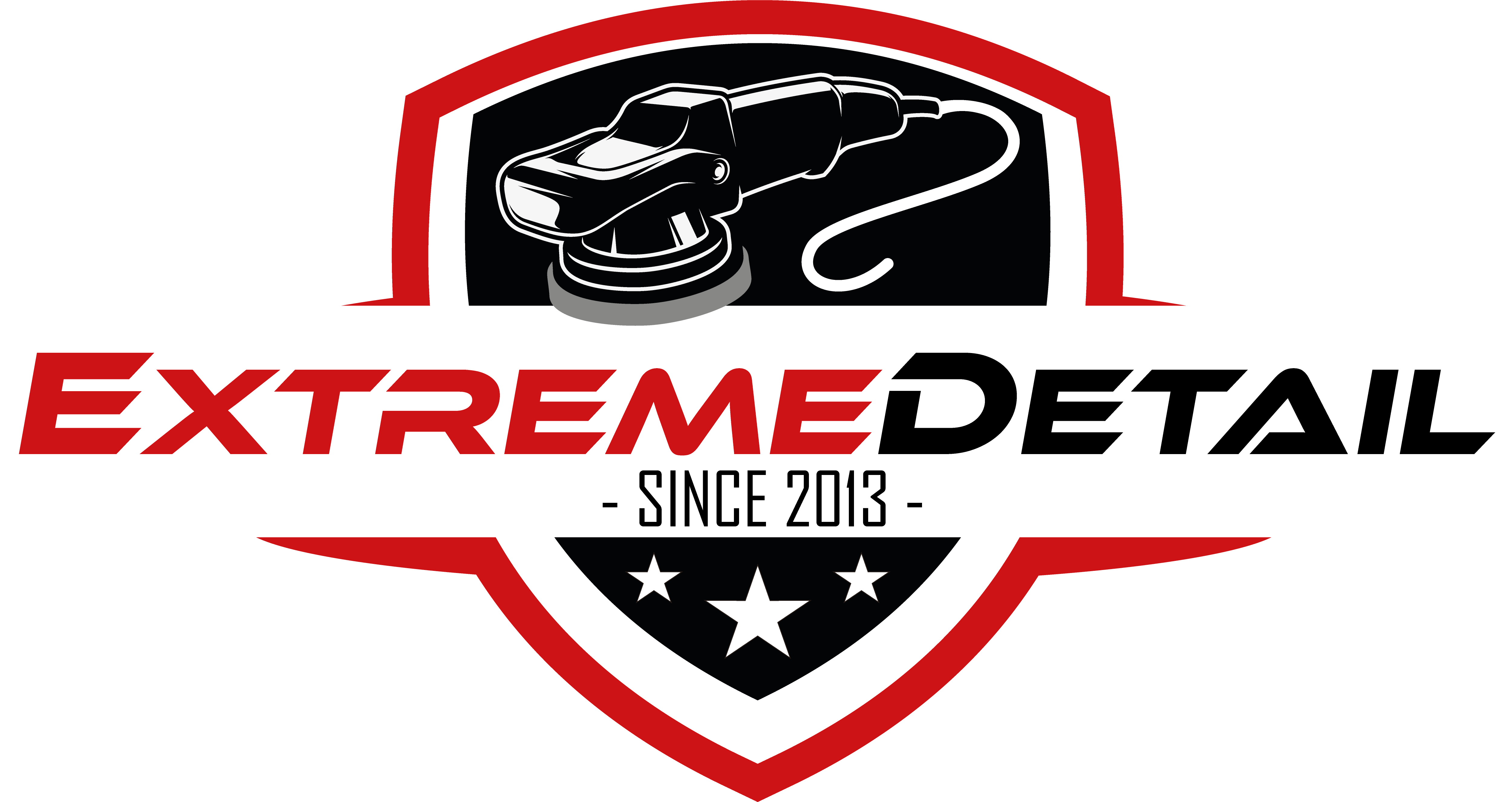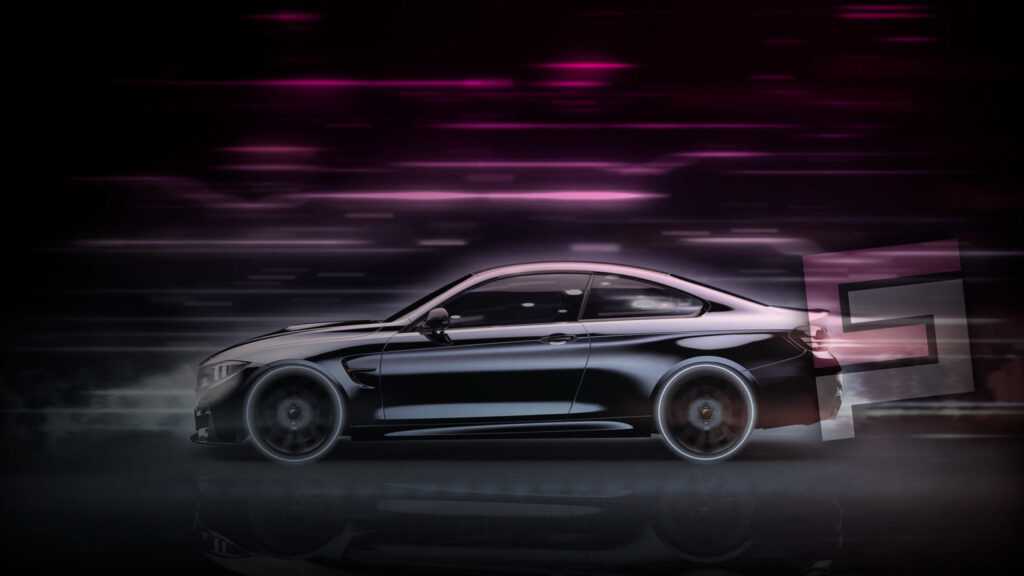
Table of Contents
Uncovering the Truth About Paint Protection Film
Paint protection film, also known as PPF, is a remarkable technological advancement that offers an exceptional level of protection for your vehicle. This thin but highly durable polymer or polyurethane film acts as a shield, safeguarding your car’s clear coat from a multitude of threats, including harmful chemicals, UV exposure, acid rain, and road debris. The protective properties of PPF can potentially save you significant costs in auto body repairs if your vehicle encounters road debris or other hazards.
Despite its effectiveness, there is a considerable amount of information circulating about paint protection film on the internet, and not all of it is accurate. Similar misleading information can be found when researching ceramic coating. To dispel any misconceptions and present a comprehensive understanding of paint protection film, this article aims to debunk myths, address rumors, and challenge false claims. We will explore whether PPF truly offers protection against light scratches and investigate its reputed self-healing capabilities.
By shedding light on the truth about paint protection film, we aim to provide a definitive guide for vehicle owners seeking to protect their prized possessions from potential damages and maintain their vehicles’ appearance and value over time.
Furthermore, we will acquaint you with Kavaca instant healing paint protection film, a cutting-edge PPF that stands as the most advanced solution available in the market. In addition to this, we’ll elucidate the benefits of complementing the PPF with a professional-grade ceramic coat, forming the Ultimate Shield of protection for your vehicle. For those interested in comparing PPF with ceramic coating, we offer a comprehensive article that you can refer to after reading this one.
What is Paint Protection Film?
To truly grasp the significance of paint protection film, delving into its history becomes essential. Like many remarkable advancements of today, PPF emerged as a solution to a problem. During the Vietnam War, the United States Department of Defense faced issues with the rotor blades of their helicopters being damaged by shrapnel, trees, and other debris.
3M was called upon to develop a protective layer that was both lightweight and incredibly robust. The solution came in the form of “helicopter tape” or a specialized urethane film, engineered for functionality rather than aesthetics.
Today’s PPF has evolved significantly from its origins as helicopter tape. It now consists of thermoplastic urethane, transparent and customizable in color and texture to enhance gloss or matte paint finishes. This clear paint protection film is available in various grades and thicknesses, meticulously applied by highly skilled professionals with precision and accuracy.
Indeed, the modern paint protection film offers numerous advantages, such as:
- The paint protection film is designed to withstand and resist the harmful effects of acidic corrosion and contaminants like bug residue and bird droppings.
- It acts as a protective shield for the painted surface, providing defense against the damaging impact of acid rain, mineral deposits, and both soft and hard water spots.
- By reducing the impact of UV light, the film helps prevent oxidation on the factory paint, preserving the overall appearance of the vehicle.
- As a strong barrier, it effectively blocks small rocks, gravel, tree branches, and other hard objects from causing damage to the paint surface while driving.
- The paint protection film is known for its exceptional longevity, offering reliable protection for over ten years, ensuring your vehicle stays shielded for an extended period.
- With its unique self-healing properties, the protective film has the ability to repair itself when scratched or struck, maintaining its protective integrity.
What are the Types of Paint Protection Film?
In today’s market, there is a wide range of car coatings available, but paint protection film stands out as one of the most superior and effective solutions. The pioneers in this field, such as the 3M Corporation, initially developed PPF with the purpose of safeguarding helicopter rotor blades from swift damage. Today, numerous brands, including well-known ones like Kavaca, 3M Paint Protection Film Pro Series, Llumar, Suntek, and Xpel film, offer various types and designs of PPF to cater to car enthusiasts.
However, it’s essential to understand that the brand name of PPF doesn’t always correlate with its specific properties or materials. This common misconception can lead to confusion among car owners. Some films come as full wraps, while others are designed for partial hood protection. Additionally, the warranty coverage varies, with certain products offering limited warranties and others providing extended 10-year protection.
To clarify these aspects, let’s delve deeper into the details.
What is Clear Bra?
Undoubtedly, the most widely recognized term in the paint protection film market is “Clear Bra.” This name serves a dual purpose, similar to how people commonly refer to all sodas as “Coke” or sealable plastic bags as “Zip-Lock.” Clear Bra is both a brand name for a specific type of protective film and a specific brand itself.
This protective film is strategically applied to the front end of the vehicle, providing coverage to essential areas such as the front bumper, grille, headlights, splitter, and even extending to the front portion of the hood and front fenders. The term “bra” is used to describe the location where the film is applied, akin to the idea of a traditional car bra that protects the front of the vehicle.

In the past, car enthusiasts often used leather or hard vinyl-based materials to cover the front of their vehicles, aiming to achieve the same goal of protecting the automotive paint.
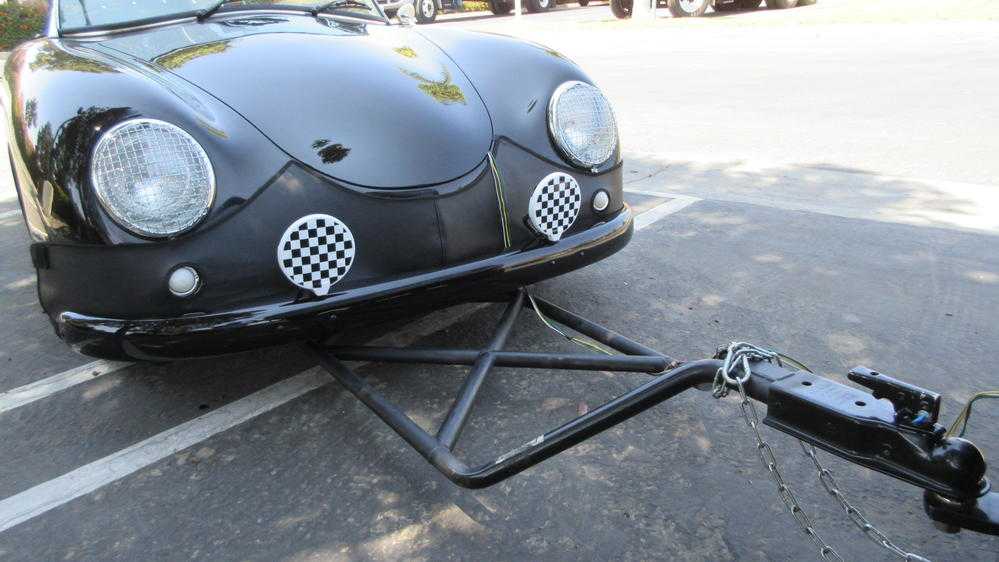
As shown in the image above, the “Clear Bra” is a form of PPF that replaced the colored and thick material, representing one of the earliest options in paint protection films accessible to car owners.
What sets apart vinyl from PPF (Paint Protection Film)?
If you’ve come across previous articles discussing PPF buying tips, you might have encountered the confusion between paint protection film (PPF) and vinyl wraps. To clarify, PPF is a durable, lightweight material with excellent stain resistance, designed to protect the vehicle’s paint from stone chips, light scratches, bug splatters, swirl marks, and other damages.
On the other hand, vinyl wraps are thicker, heavier, and often come in various colors and graphics. They serve as decorative elements and can be applied over the original paint of a vehicle, offering both protection and a unique appearance. An example of a vinyl wrap is showcased in the image below, featuring David Douthit’s Quartermaster Nostalgia Jet Funny Car, where the bottom of the car is wrapped in branded vinyl, which even illuminates when the car is turned on.

Describing the Science Underlying Paint Protection Film
Sure, let’s dive into the technical details. The majority of automotive paint protection films share a common physical structure, which is composed of four distinct layers:

Polyester Release Liner: This is the bottom layer of PPF. It measures about 3.0 mils (or 0.076mm) in thickness. Once it’s removed, it exposes the material that provides the bond to the vehicle surface.
Acrylic Adhesive: The next layer up is the acrylic adhesive. It’ is a bit thinner – measuring 1.6 mils (or 0.040mm). This provides the durability of adhesion.
Polyurethane: The bulk of PPF is polyurethane. This provides the depth and strength of the paint protection film and measures 6.0 mils (0.152mm).
Clearcoat: The final layer is clearcoat. It measures 0.5 mils (0.0132mm) and acts as the surface layer of the PPF. It is also what helps a ceramic coating like Ceramic Pro to bond on top of the PPF. Some self-healing PPF’s are topped with an elastomeric polymer that helps the material maintain its natural shape once it has been stretched or applied.
How does paint protection film (PPF) achieve the remarkable ability to self-heal?
To make it clear, not all paint protection film products available in the market have the self-healing capability. Only those formulated with Elastomeric polymers possess this remarkable feature. “Elastomeric” is an adjective used to describe materials with elastomers, which are cross-linked polymers with a loosely attached structure. These elastomers are essentially synthetic or natural rubbers that can return to their original state once the source of damage is removed. When applied as a paint protection film, the Elastomeric property allows the film to undergo self-healing, effectively repairing minor scratches and damages on its surface, providing an added layer of protection for the car’s paint.
The self-healing attribute of PPF with Elastomeric polymers makes it an excellent choice for automotive paint protection. It ensures that the film can maintain its pristine appearance even after encountering light abrasions or small scratches during regular use. The ability to heal itself sets this type of paint protection film apart from other conventional options, offering car owners greater peace of mind and confidence in protecting their vehicle’s paint from everyday wear and tear.
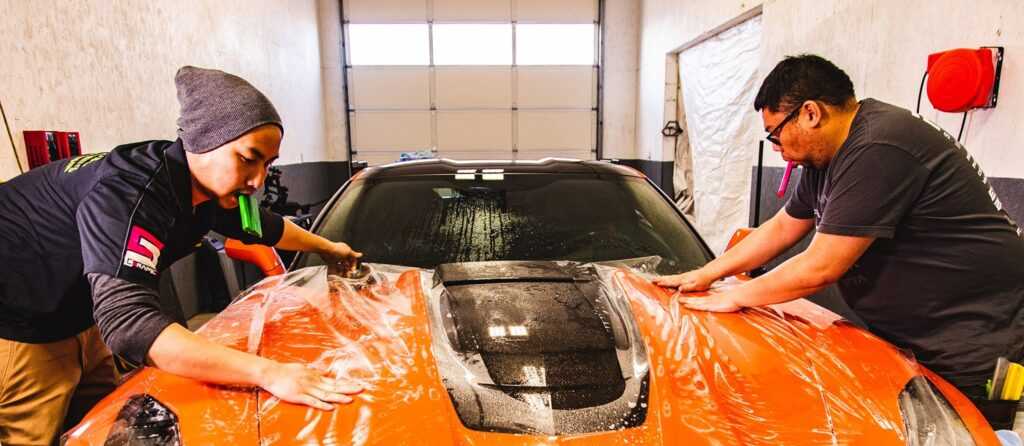
When a premium paint protection film is made with Elastomeric polymers, it has the remarkable ability to self-repair minor scratches or small tears resulting from impacts like rocks. However, it’s important to note that the term “self-healing” can be slightly misleading, as the repair process necessitates an external action, such as the application of heat from the sun or a heat gun. Nevertheless, the film’s unique capability to undergo this healing process makes it highly effective in maintaining the vehicle’s paint in excellent condition and protecting it from potential damage caused by everyday hazards.
The Quest for True Self-Healing PPF
Many people often wonder about the functioning of PPF or paint protection film. As explained earlier, the scientific composition of these advanced materials provides protection against common road debris, preventing damage to the vehicle’s surface. In the event of a strong impact, the PPF might get scratched, and this is where the self-healing properties of paint protection film come into play.
For a product to be genuinely self-healing, it should have the capability to repair itself without external intervention. An innovative paint protection film called Kavaca, developed by Ceramic Pro, is a true Instant Healing PPF. To learn more about how Kavaca works, watch the video below.
What is the Installation Process for Paint Protection Film?
Similar to other paint protection methods, the proper preparation, precise installation, and careful maintenance play a significant role in the effectiveness of a PPF. While Ceramic Pro is renowned for its ceramic coatings, they also produce an exceptional clear bra material called Kavaca. Whether you opt for a clear bra pattern or full coverage, the installation process typically involves the following key steps:
Step One – Prep Work for Paint Protection Film Installation
In order for a PPF to effectively protect, it needs to be firmly bonded to the surface. This is achieved by ensuring the surface is thoroughly cleaned, devoid of any debris, and free from damage. The transparency of the paint protection film means that the condition of the underlying paint or surface significantly impacts the final appearance and brilliance of the applied product.
What is a Decontamination Car Wash? The initial stage of preparing the surface for PPF installation often involves a decontaminating car wash. This process utilizes a specialized car shampoo that acts as a wax-stripping detergent, effectively breaking down wax and factory paint sealant, allowing them to be washed away.
For vehicles that already have a ceramic coating applied to the entire surface, the professional detailer installing the clear bra film will typically proceed with a maintenance car wash. However, in cases where there are minor scratches resulting from rock chips or if the vehicle’s paint is older and has imperfections, the auto detailing company may address these issues during the subsequent steps of the installation process.
What is Paint Correction? After the surface has undergone the initial cleaning and debris removal, the installer will carefully examine the condition of the paint. If they observe fading, aging, spider-webbing, swirl marks, or any signs of damage, they will suggest paint correction to the client.
Paint correction involves using polishing techniques or a cutting compound to eliminate minor scratches and imperfections from the paint. This meticulous process results in a flawlessly smooth surface that not only facilitates the bonding of the PPF but also enhances the overall brilliance and appearance of the finish.
Final Wipe Panel Wipe Down: The authorized and certified PPF installer will employ a unique combination of chemical agents, specifically designed for the task, to effectively eliminate any contaminants, excess polishes, or oils present on the surface. This crucial step ensures that the surface is impeccably clean and ready for the precise application of the paint protection film.
Step Two – Pre-Cutting the Material
There are two primary techniques for applying PPF, with most professional installers utilizing a plotter or machine to pre-cut the material into smaller, custom-fit sections, such as fenders or door edges. This approach not only reduces waste and saves both the client and installer money but also expedites the installation process, ensuring a better fit for intricate areas like door jams, headlights, and grilles.
The second method involves using bulk film, typically employed when an installer lacks a plotter. This approach may result in excess material, longer installation times, and potentially less precision and accuracy. However, experienced installers can still achieve excellent results, often hand-cutting to precisely fit various parts of the vehicle, including rocker panels, side mirrors, hoods, deck lids, and spoilers.
Step Three – Fitting
To ensure precision and accuracy, the installer will conduct a pre-fit of the paint protection film on the vehicle. With numerous brands and installation types available, such as clear bras designed specifically for the front of the vehicle, this process becomes meticulous and exacting. Each section of the clear bra is carefully fitted to the paintwork, ensuring a seamless connection and minimized gaps between the pieces.
While this pre-fit process may add some extra time to the overall installation, the benefits are well worth it. The clear bra provides essential protection to the vehicle’s paintwork and other vulnerable areas, guarding against rock chips and light scratches that can be easily remedied with self-healing PPF properties.
Step Four – Spraying the Fitting Solution
The activator used to facilitate the bonding of the clear bra or PPF to the surface is known as a fitting solution. This solution is applied to both the painted surface and on top of the PPF, activating the adhesive, which essentially acts as a strong glue, creating a tight bond with the surface.
It’s important to note that each brand of PPF comes with its recommended fitting solution properties, which can vary from distilled water to chemically-activated agents. This solution plays a crucial role in ensuring that the PPF adheres effectively to the car’s paintwork, providing protection against UV rays, oxidation, corrosion, and preventing the formation of rust over time.
Step Five – Application and Final Fit
This is the crucial step where the magic happens. The skilled PPF installer meticulously glides the PPF into a perfect fit. It involves a series of actions, such as fitting the film, spraying the solution, adjusting its position, and using a squeegee to eliminate any bubbles or creases. Once the PPF clear bra is precisely in place and bonded to the paint surface, it creates an exceptional sealant that offers superior protection to the car’s exterior, guarding against everyday nuisances like scratches, bird droppings, and rock chips.
Step Six – Drying
Once the PPF or clear bra has been meticulously applied, the final step of the installation process is drying. There are several methods for this, either by allowing it to dry naturally over time or through a specialized drying procedure. Many professional PPFs are heat-activated using a heat gun or placed in a heat chamber. This activation process essentially triggers the adhesive properties of the film, ensuring a tight and secure fit to the vehicle’s surface. This final step further enhances the effectiveness and longevity of the paint protection film, providing exceptional protection against various elements.
Duration of Paint Protection Film Performance
The performance of a properly applied paint protection film is projected to last between five to ten years. Nevertheless, various factors can influence the longevity of the PPF, just like any other paint protection method.

The Prep Work
As mentioned earlier, the condition of the surface before applying the PPF plays a crucial role in determining the longevity of the automotive protection. A clean and scratch-free surface allows the adhesive to bond effectively, resulting in a tighter and more durable fit.
The Application
Engaging a certified paint protection film installer to handle the entire process is another effective method to prolong the lifespan of your PPF. These professionals use high-quality materials and supplies, ensuring the best results for your vehicle. Trusted PPF brands, such as Ceramic Pro PPF Kavaca, collaborate with skilled and certified detailers to provide top-notch service. Working with a reputable PPF dealer reduces the chances of air bubbles in the final application, resulting in a seamless and aesthetically pleasing finish.
In contrast, cheap and inferior top coat materials found in low-quality products may lead to issues like yellowing or staining. Additionally, such products may offer limited protection against bug acids and other contaminants.
Environmental Factors
Although paint protection film (PPF) is designed to shield the surface from various environmental elements like UV light, acid rain, and bird droppings, excessive exposure can lead to undesirable outcomes. To counter this, applying a high-quality nano ceramic coating over the PPF offers an extra layer of protection, extending the PPF’s lifespan significantly. In certain instances, this combination can even last for the entire lifetime of the vehicle.
What are the advantages and disadvantages of using Paint Protection Film (PPF)?
Let’s be straightforward and present the truth. Paint protection film may not suit everyone’s needs. Although it effectively minimizes scratches, rock chips, and other surface damage, it comes with its own set of advantages and disadvantages that you should carefully weigh.
Pros of Paint Protection Film
- Most durable material to shield against rock chips and protect car paint.
- Remarkable healing abilities akin to Wolverine, or even Deadpool-like instant healing with products like Kavaca.
- Effectively prevents paint scratching, marring, or swirl marks.
- Longest-lasting paint protection solution available, lasting up to 10 years or more when paired with a high-quality nano coating.
- Improved engineering and technology ensure no yellowing or diminished hydrophobic properties as experienced in the past.
Cons of Paint Protection Film
- Many grades of PPF. Not all products or brands are equal – therefore, it’s essential to conduct thorough research to select the optimal solution for your specific needs.
- Difference in Self Healing Property: Certain PPFs in the market provide exceptional paint protection with instant scratch healing capabilities. However, the majority of PPFs are considered “self-healing,” requiring the application of heat or specific repair methods to eliminate surface scratches.
- Not a DIY solution. A paint protection film is a high-quality, clear film designed for professional application by experts. Although there are DIY clear bra products available, their results typically do not match the level of protection and performance provided by professional-grade PPF installed by certified technicians.
- It’s an investment. There’s no denying it – PPF comes with a significant cost. However, it’s essential to view it as an investment in preserving the quality and condition of your vehicle. To ensure the best results and long-lasting protection, it is highly recommended to collaborate with a certified PPF dealership or authorized detailer. Their expertise and experience will make a difference in achieving a professional and satisfactory outcome.
Extending the Lifespan and Efficacy of Paint Protection Film
As previously mentioned, one of the most effective methods to safeguard and improve the performance of your paint protection film is by having a high-quality nano-ceramic coating expertly applied over it.
A Ceramic Pro solution contains a blend of silicon dioxide (SiO2), titanium dioxide (TiO2), and exclusive polymers and ingredients, forming a robust protective layer over the paint protection film (PPF). Essentially, it acts as a liquid version of quartz or glass, seeping into the tiny pores of the PPF’s top layer and solidifying into a smooth and level surface. This ceramic coating extends its benefits to other areas like headlight covers, glass, carbon fiber, and vinyl wraps. Once applied, it creates a hydrophobic surface, making water, dust, debris, tree sap, bug splatters, and other contaminants less likely to adhere, leading to a remarkable super hydrophobic effect.
Advantages of Utilizing Ceramic Coating Over PPF
When you administer a nano ceramic coating specifically formulated to bond with the selected PPF material, it can offer numerous advantages.
Increased Depth and Shine: Once a nano ceramic coating undergoes the curing process, it transforms into a thin glass-like layer with the strength of quartz. This enhancement magnifies the luster of the paint beneath the PPF, intensifying the depth of the underlying finish, whether it be glossy or matte.
Improves Hydrophobic Properties: Hydrophobic refers to the ability of a surface to repel water effectively. Aside from creating visually appealing water beading and shedding effects, it also plays a role in minimizing the adherence of dirt, pollen, and other contaminants. To illustrate, if you have an aversion to pigeon droppings, a ceramic-coated PPF makes it effortless to clean and remove their mess from your vehicle’s surface.
Extended Lifespan: The potency and resilience of a professional-grade Ceramic Pro coating surpass even the finest DIY nano coatings. These high-quality coatings contain over 90 percent SiO2, which is approximately 10% more than the leading self-applied coating. Consequently, this yields a more robust and enduring coating that enhances the longevity of the PPF while retaining its self-healing attributes.
What's the Final Verdict on Paint Protection Film (PPF)?
Similar to various car care products like car wax, ceramic coatings, and paint sealants, there is a wide array of paint protection film (PPF) products available in the market. If you’re considering investing in a high-quality PPF, it’s essential to keep the following factors in mind.
- Thorough Research: Before making any significant purchase, conduct extensive research on the PPF product you intend to buy. This also includes researching the credibility and expertise of the installers offering PPF services.
- Authenticity of Claims: PPF is generally less susceptible to misleading marketing tactics, but it’s still crucial to verify the manufacturer’s claims through unbiased third-party reviews and understanding the technology behind the PPF to ensure it delivers on its promises.
- Instant Healing Capability: One of the most appealing features of paint protection film is its ability to self-heal minor scratches and damages. However, it’s vital to confirm whether the PPF you choose truly possesses this property, as having to visit the installer for every minor scratch could lead to additional time and expenses.
What is the Best PPF in 2023?
Choosing to invest in an Instant Healing PPF like Ceramic Pro’s Kavaca will provide you with a reliable and authentic self-healing solution. Unlike other PPF products, Kavaca is uniquely engineered with nano-technology, enabling it to self-heal without the need for professional intervention. This exceptional PPF offers top-notch protection and has an impressive lifespan of 10 years or more, making it the ultimate choice for long-lasting and superior protection for your vehicle.
KEY PROPERTIES:
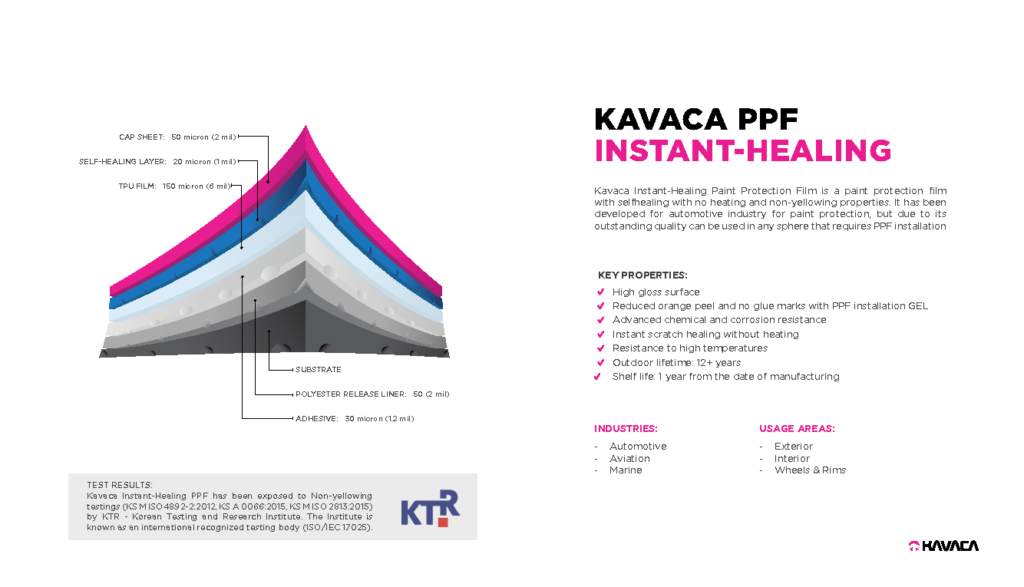
Your vehicle is a reflection of your passion. If you seek the finest paint protection film available, simply click the button below to obtain a personalized free estimate.
